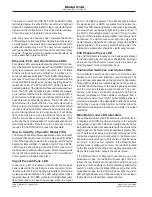
Model 214A User Guide
Issue Preliminary 1, October 2022
Studio Technologies, Inc.
Page 17
Model 214A
ANNOUNCER’S CONSOLE
may make the main and talkback pushbuttons more diffi
-
cult to identify. High may also be useful when identification
markings have been inserted under the clear lens caps.
System – Relay Output 1
Choices are
Off
,
Main Button
,
Talkback Button
, and
Main and Talkback Buttons
.
This configuration choice selects when relay output 1 will
be enabled.
Off:
When relay output 1 is configured for off, the contact
associated with relay output 1 will never close (short). This
setting would be appropriate when relay output 1 is not
being utilized.
Main Button:
When relay output 1 is configured for main
button, the contact associated with relay output 1 will close
(short) whenever the main button function is active.
Talkback Button:
When relay output 1 is configured
for talkback button, the contact associated with relay
output 1 will close (short) whenever the talkback button
function is active.
Main and Talkback Buttons:
When relay output 1 is config
-
ured for main and talkback buttons, the contact associated
with relay output 1 will close (short) whenever the main or
talkback button functions are active.
System – Relay Output 2
Choices are
Off
,
Main Button
,
Talkback Button
, and
Main and Talkback Buttons
.
This configuration choice selects when relay output 2 will
be enabled.
The exact functioning of the choices for relay output 2 is
identical to those provided for relay output 1.
System – Dante Aux Output
Choices are
Off
,
Hot Mic,
Tally Tone
, and
Main with
18 kHz Tone
.
The Dante aux transmitter (output) channel is available
for special applications and is capable of providing a vari-
ety of audio signals. Each configuration choice has been
carefully selected and may prove useful in sophisticated
applications. If the Dante aux transmitter (output) channel
is not going to be utilized then the
Off
configuration choice
should be selected.
When
Hot Mic
is selected, audio associated with the output
of the Model 214A’s microphone preamplifier will always be
present on the Dante aux transmitter (output) channel. The
Hot Mic function can be very useful but has the potential for
abuse. By the very nature of a hot mic function, no button
press by the user can cause the audio signal on the Dante
aux transmitter (output) channel to become inactive. Users
must be aware that audio from the microphone preamplifier
will always be present on this Dante transmitter (output)
channel.
When
Tally Tone
is selected, a 20 kHz sine wave signal
at a level of –20 dBFS will be present on the Dante aux
transmitter (output) channel whenever the main output
function is active. This is provided as a control signal for
use in REMI/At-Home or other specialized applications. A
20 kHz tone being present on the Dante aux transmitter
(output) will serve as a tally signal indicating that audio can
be present on the Dante main transmitter (output) channel.
Main with 18 kHz Tone
is an interesting configuration
choice. Whenever the Dante main transmitter (output)
channel is active the signal on the Dante aux transmitter
(output) channel will consist of a combination (sum or mix)
of audio from the output of the microphone preamplifier
and an 18 kHz sine wave tone. In this way, the Dante aux
transmitter (output) can prove to be especially useful for
REMI/At-Home applications. Other products from Studio
Technologies, including the Model 5422A Dante Intercom
Audio Engine and the Model 391 Dante Alerting Unit, can
directly utilize this signal.
Operation
At this point, the microphone, headphone, Ethernet, and,
if required, 12 volts DC power connections should have
been made. The pushbutton labels may have been revised.
The desired configuration should have been made using
the STcontroller software application. The Dante transmit-
ter (output) and Dante receiver (input) channels should
have been routed (subscribed) using the Dante Controller
software application. Normal operation of the Model 214A
can now begin.
Initial Operation
The Model 214A will begin functioning a few seconds after
its power source is connected. As previously discussed,
the power source can be provided by Power-over-Ether-
net (PoE) or an external source of 12 volts DC. If both are
connected, the PoE source will power the unit. Should PoE
subsequently no longer be available uninterrupted opera-
tion will continue using the external DC source.
Upon Model 214A power up most of the status and button
backlight LEDs will activate in a test sequence. The PoE,
USB, and SIG/PEAK LEDs, located on the back panel,
will light one after another. On the unit’s top surface, the
two status LEDs and the backlight LED associated with
the main pushbutton switch and the status and backlight
LEDs associated with the talkback pushbutton switch will
momentarily light in sequence. Once that sequence has
completed all the LEDs will begin to function normally.











































